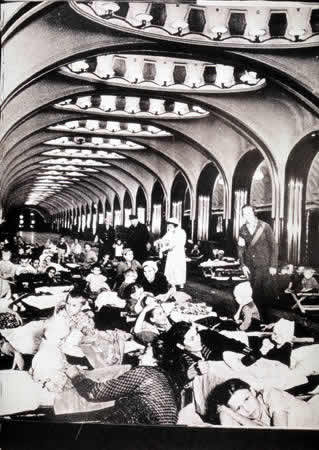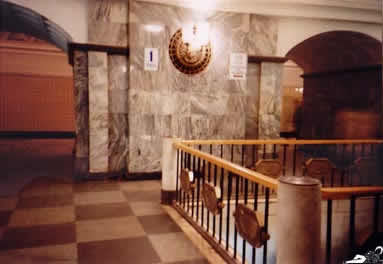The
Moscow Underground
The building of the underground lines started in the early 30-ies. The forced industrialization of the young Soviet power had led to a rapid growth of the cities, most of all Moscow, and in order to secure the availability of this huge workforce, still growing at this time, the infrastructure of Moscow had to be re-thought and re-modelled. One part of this modernization was the Underground.
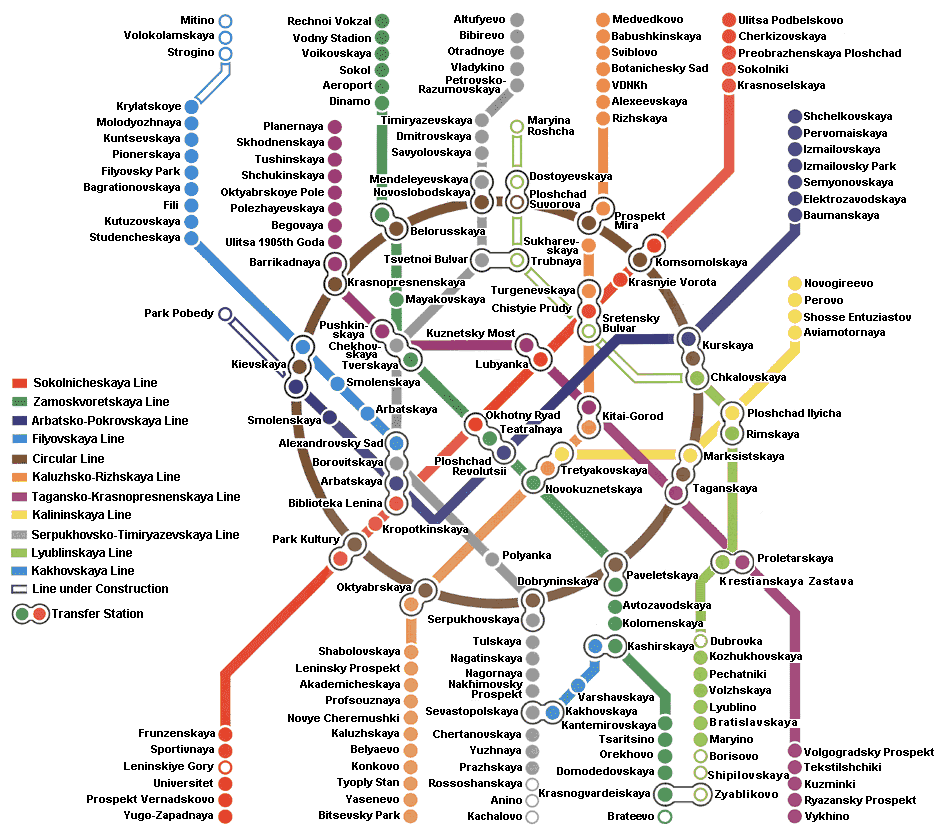
The planning and building of the Moscow Underground is
linked to the personality of Lazar Kaganovich (1893-1991), whose name
it bore for the first 20 years of its existence. Later it was renamed
the "Moscow Lenin-Underground".
| Kaganovich, descending from a humble family of Ukrainian Jews, rose to one of the most faithful and therefore powerful followers and collaborators of Stalin and was removed from power in the years following Stalin’s death in 1953. After 1957 he fulfilled minor tasks in remote provincial areas, then lived a quiet life as pensioner in Moscow until he committed suicide in 1991 as a reaction to the events that marked the end of Soviet Union, his spiritual home. | 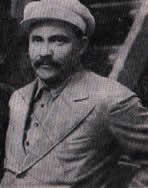 |
A picture of Kaganovich from an article about the first Underground Line |
Kaganovich was then – when the underground was planned and construction started – the head of the City Soviet of Moscow, in 1935 he became the People’s Commissioner for Transport. From 1930 on he was the man responsible for the reconstruction of Moscow.
He also ordered the destruction of the Church of Christ
the Saviour in the place of which the Palace of the Soviets should be
built – which never came into existence as it turned out that the
underground was rather instable. The new Church that has been built in
the place of the destroyed one, – mostly from concrete and very quick
in order to be ready for Moscow’s 850th anniversary – is probably
going to face serious problems one day.
(So perhaps Kaganovich was right ... )
| In this place in the subway connecting the underground stations of Okhotniy Ryad and Ploshchad Revolyutsii (or Teatralnaya) one can feel the passing of time ... | 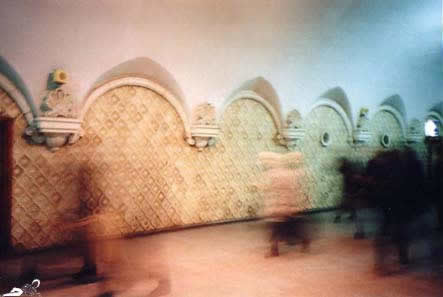 |
The first Soviet Underground system should not only be
functional, that is, it should not only be able to transport the members
of the young Soviet proletariate smoothly to their respectable workplaces,
but it should also – as the rebuilding of Moscow in general –
be a proof that the first proletarian state could outdo the Capitalist
West, and even surpass it. The Moscow Underground was to be better, more
effective and more beautiful than any underground system existing so far.
Despite the official version presenting the construction
of the underground as a purely socialist achievement, western experts
were employed in the technical planning.
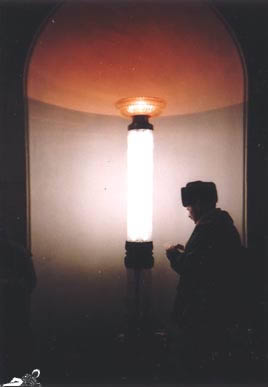 |
A lamp and niche in Kurskaya/Ring Line Station and someone making use of it.
The architecture and design of the underground also reflects the socialist concept of art: Art belongs to everybody, it should be first of all in public places, accessible to everyone. People should not have to go to special places to enjoy pictures, architecture or theater, but it should be present in their everyday life. Not all the results of this concept have been as convincing as the Moscow Underground. |
The speed in which the underground lines had to be constructed
led to many mortal casualties among the workers about which official figures
never have been made public. The majority of the workers employed were
young people, members of the Komsomol, and many of them came from the
countryside. There are rumours that not all of the people working in the
underground construction did this voluntarily.
Many architects and artists worked on the design for some decades, and
an incredible amount of expensive materials was used, in a time when many
of the workers employed in the construction lived in wooden barracks,
without electricity or water.
|
The first line, from "Park Kultury" till
"Sokolniki", was opened in May, 1835. It had a branch
from the station "Okhotny Ryad" to "Smolyenskaya",
and covered a trayectory of about 11 km.
Mayakovskaya Station serving as a shelter during bomb raids. |
|
By 1946 three more lines had been added to the original ones. The ring line was built between 1950 and 1954.
The Moscow Underground is still growing. As far as functionality and maintenance are concerned it is in far a better shape than the London or New York Underground. After the collapse of Soviet Union and in the course of the economic crisis following it the Underground has become a shelter for homeless. And, as public transport worldwide, it has turned into a target for terrorists.
The Sokolnicheskaya Line
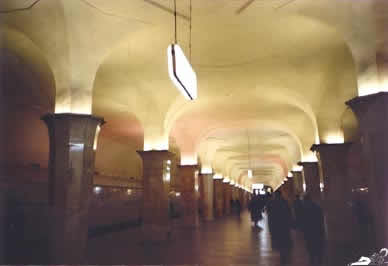 |
Kropotkinskaya Station (opened 1935) is one of the oldest stations, on the first, the Sokolnicheskaya Line. The line is now named after the station that then was its end, Sokolniki, but in the beginning it was named "Kirovsko-Frunzenskaya".
The station was originally called "Palace of the Soviets", as a reference to the planned construction of such a building |
in the place of the Cathedral of the Saviour. Some of the marble used in this station allegedly was taken from the demolished cathedral. A model from this underground station was presented at the World Exhibition in Paris in 1937 and won a prize there.
As the Palace was never built the station was renamed, remembering Pyotr Kropotkin.
Kropotkin was a Russian anarchist whose activities took place before the October Revolution. He was forced into exile by persecution of the Tsarist authorities, and spent most of his life in Switzerland, France and England. He wrote some books on how Revolution should be made and how Socialism should be organized. It is doubtful whether the Soviet leaders have read these books, at least they followed another concept than Kropotkin.
Now there are rumours that the station should be called "Station of the Saviour". First, this would be quite a change to the name it now bears. Second, it would sound strange as the next station is the Lenin-Library.
|
Frunzenskaya (opened 1957) The name of this station is also commemorating Frunze, the military commander and theorist. |
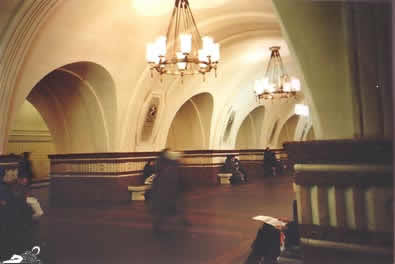 |
With the opening of the Sokolnicheskaya Line also the first escalators to the underground were inaugurated. The trains had 4 wagons each, and the daily average transport capacity was 177.000 passengers.
| Okhotniy Ryad, passage connecting to Teatralnaya: detail from the ceiling | 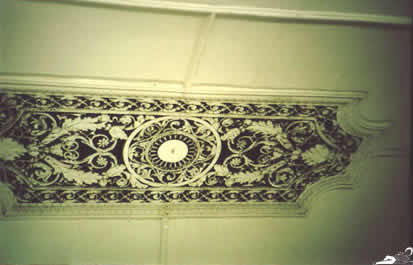 |
One station on this line was below the Lyubyanka, the center of the Secret Service. It obviously was very important to connect this place with the Kremlin and the outskirts ...
|
Lyubyanka Station (, opened in 1935) Before it was named Dzherzhinskaya after Felix Dzherzhinskiy, the first head of the Cheka, the precursor of the KGB |
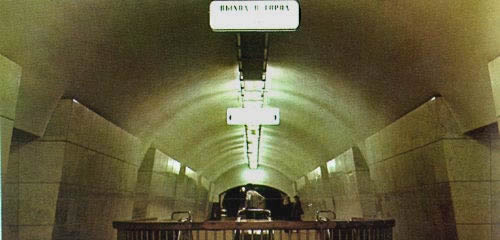 |
Looks quite gloomy, doesn’t it? – Still it must be stated that this station underwent thorough reconstruction in the 70-ies and I didn’t manage to find a picture showing its original appearance.
The Zamoskvarechkaya Line
This was the second line to be built. In the beginning one of the main aims was to unite the center, that is the Kremlin, with the numerous Moscow train stations. While the first underground line’s Komsomolskaya Station is situated below the "place of the 3 train stations", the Leningrad, Kazan and Jaroslawl stations, the Zamoskvarechkaya Line leads to the Paveletski (southward direction) and Belorussian stations (northward direction).
The name of the line means: "the line that leads across the river Moskva".
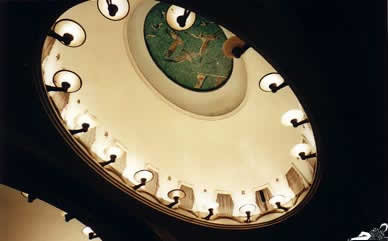 |
Ceiling decoration and illumination in Mayakovskaya station (opened 1938). The station is named after the poet Vladimir Mayakovsky, an ardent follower of the October Revolution and Socialist society who committed suicide in 1930, at the age of 37, probably disilusioned about the way things had been developing. |
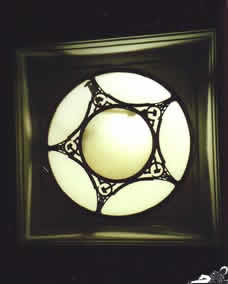 |
Lamps in Mayakovskaya Station During World War II, this station was used as a command center for anti-aircraft batteries. |
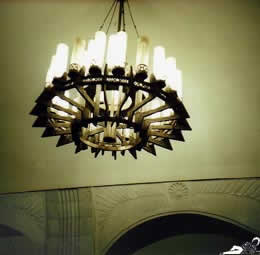 |
In 1938, though, only the northward bound part was opened, till the station "Sokol." The line was then called "Gorkovsko-Zamoskvarechkaya". For a while after his death in 1936 Maxim Gorkii was very popular and a lot of buildings and institutions were named after him, but later he fell from favour and his name was removed from most public places.
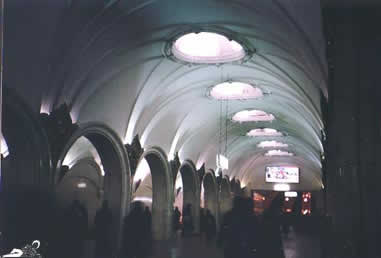 |
Paveletskaya Station (built and opened during the war, in 1943) It was constructed in war times and is situated below Paveletski train station – which before World War II had been called Saratov station, beginning of a train line leading south.
|
|
This is the Paveletskaya Station on the Zamoskvarechkaya Line. There is a different station on the Ring Line that was built later.
Details from the ceiling,
the illumination ...
|
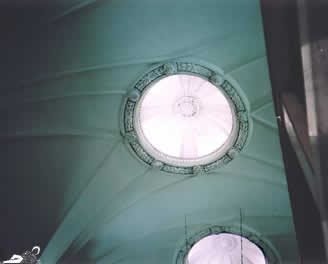 |
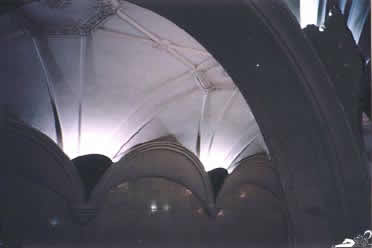 |
... the vaults ...
... and again the illumination ...
... of Paveletskaya Station. |
|
Novokusnyetskaya Station (also built during the war and opened in 1943)
The marble around the benches used here allegedly also originally decorated the Cathedral of the Savior.
|
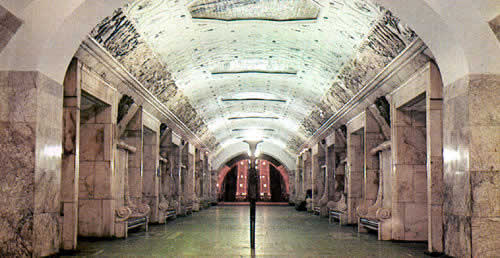 |
The Arbatsko-Pokrovskaya Line
This line was built, used, then replaced by a parallel line, and later again used, as part of a much longer line leading northeast from the center. What is now called Arbatsko-Pokrovskaya is the later and deeper one, the original became part of the Filichevskaya Line.
The reason for this strange parallelism is that during World War II a bomb fell on the original line, making a big hole in the tunnel, and showed that this line was too near the surface to withstand aviation attacks. As this line was supposed to lead to Stalin’s dacha later it was decided to build a deeper line which was not in danger to be destroyed by airplane bombs.
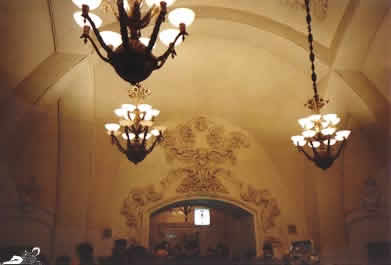 |
There are two stations named "Arbatskaya", not even interconnected, and this one is from the newer line that took over the name from the older. It’s situated on a lower level than the parallel line called "Filichevskaya" leading to the Moscow district of Fili. It’s the more luxurious of the two stations, that’s for sure. The bench below, for example, consists of oak and marble. And there are a number of them in Arbatskaya Station. Arbatskaya Station (deep) was opened in 1953. |
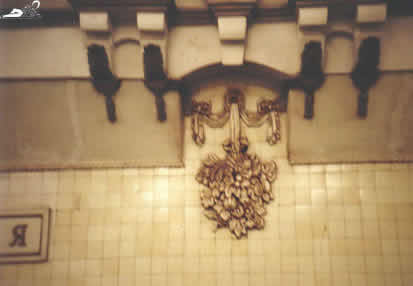 |
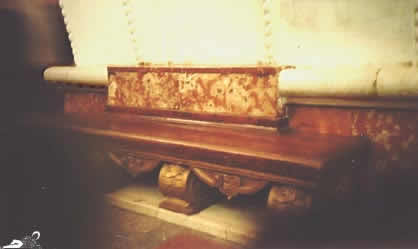 |
Arbatskaya Station is named of the main shopping and recreation street, now a pedestrian zone, in Central Moscow. Smolyenskaya is named after a Russian city, not far from the border with Belarus: Perhaps in former times there was a city gate with that name, or a road named this way, leading west, towards Smolensk.
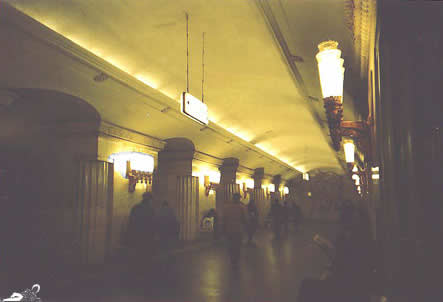 |
(Lower) Smolyenskaya Station (opened also in 1953)
|
|
Forbidden things: No running on the escalator! No high-heel shoes! No sitting on the steps! Don’t place suitcases on the banisters! Careful with umbrellas! Of course no one cares ... |
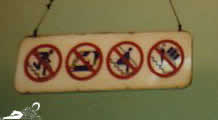 |
|
|
Kurskaya Station – opened in 1938, situated below the Kursk Train Station. |
While the lines introduced so far were all built during Stalin’s reign, the Kaluzhsko-Rizhskaya Line came into existence lateron.
The Kaluzhsko-Rizhskaya Line
|
Alekseyevskaya Station (opened 1958) is named after the village Alekseyev that was situated there before the territory was incorporated into Moscow. Also in this station was certainly no tendency to save money: The wall covering is from marble (two colours), the floor is from red granite. |
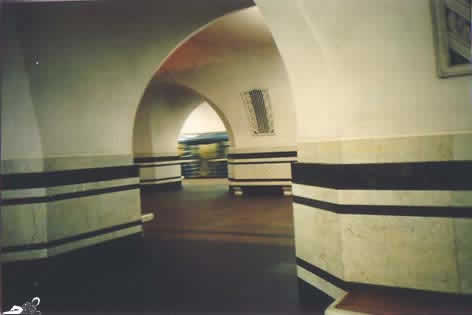 |
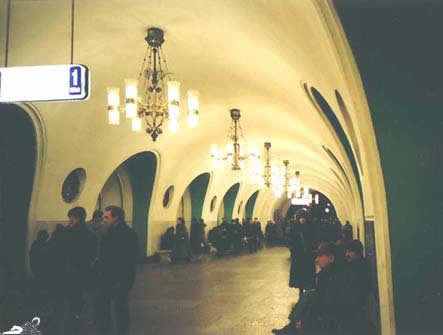 |
VDNKh Station (also opened in 1958) has a floor from red and grey granite.
These materials were introduced into the construction of the under-ground in the 30-ies, but they were used during and after the war, and, as this underground line shows, also after Stalin’s death.
|
I have no information which materials are common in nowadays underground construction, as the lines are still expanded and new stations added.
The use of marble and granite somehow ceased by the beginning of the 60-ies, but was used in most stations built before that time. Up to then the stations displayed also other very elaborate materials: Most of the mosaics are made from small pieces of coloured melted glass on ceramic, a technique called smalte; in some places there were tiles from porcelain, or a special kind of base plates named after a German town where they were invented and first produced on a large scale: Mettlach-plates.
